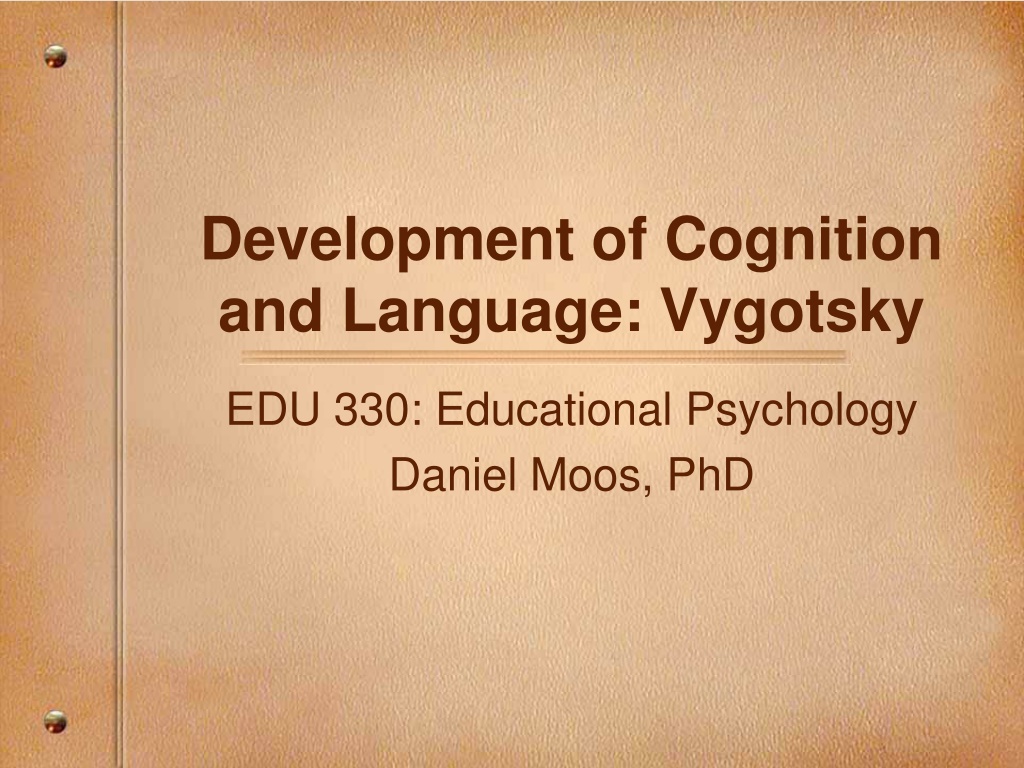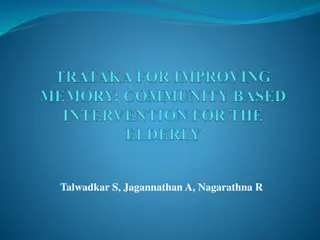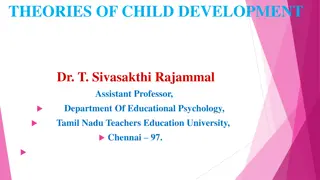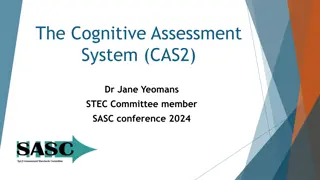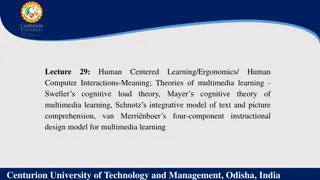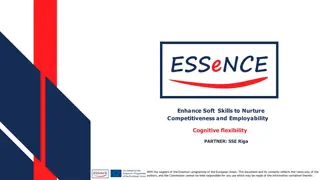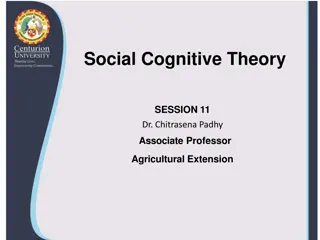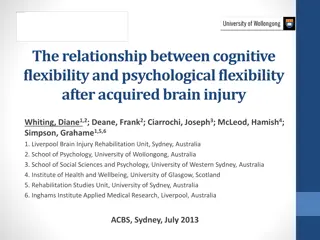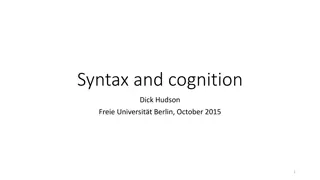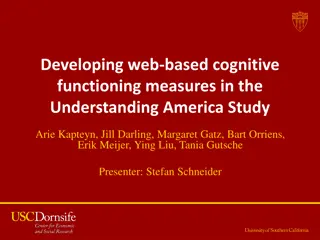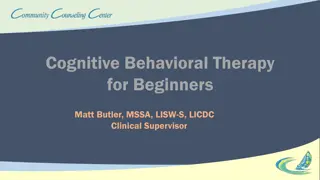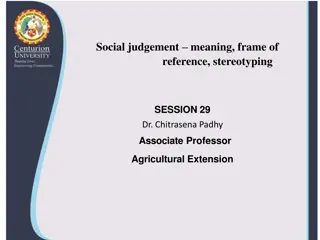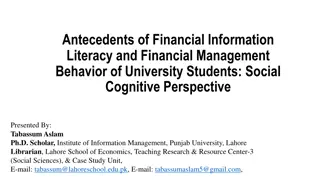Understanding Vygotsky's Social-Historical Theory of Cognitive Development
Explore Lev Vygotsky's theory of cognitive development, which emphasizes the influence of social and cultural factors on learning. Discover how language plays a central role in development and learning, with various levels of speech aiding in communication and understanding. Compare and analyze categorization techniques and assumptions about learning within different cultural contexts, such as those of the aborigines in Australia.
Download Presentation

Please find below an Image/Link to download the presentation.
The content on the website is provided AS IS for your information and personal use only. It may not be sold, licensed, or shared on other websites without obtaining consent from the author. Download presentation by click this link. If you encounter any issues during the download, it is possible that the publisher has removed the file from their server.
E N D
Presentation Transcript
Development of Cognition and Language: Vygotsky EDU 330: Educational Psychology Daniel Moos, PhD
LEV VYGOTSKY SOCIAL-HISTORICAL THEORY OF COGNITIVE DEVELOPMENT Any higher mental function necessarily goes through an external stage in its development because it is initially a social function.
Assumption Learning is best understood in the context SOCIAL & CULTURAL influences
Procedure Sort the following words into whatever categories make sense and provide a label or rationale for each category. males, females, figs, kangaroo, meat, dogs, honey, bees, the moon, cigarettes, water, sun, spear, wine, wind, fish, mud, fire, birds, rainbow
Compare Compare your categories with the following created by aborigines in Australia
Categories Bayi: males, kangaroo, the moon, rainbow, fish, spear myths and beliefs: rainbows are believed to be mythical men Balan: females, dogs, birds, fire, water, sun experience: water extinguishes fire; myths and beliefs: birds are believed to be female spirits; dangerous and exceptional things are put in a minimally contrasting category: dogs are considered exceptional animals, so they appear in the second class instead of with men Balam: figs, honey, wine, cigarettes experience: wine is made from fruit Bala: meat, bees, wind, mud
Assumption LANGUAGE plays a central role in development & learning
Role of Language (I) Language plays two roles in development: (1) Tool to communicate (2) Tool in learning Levels of speech: Preintellectual speech: Communicate needs and social contact (e.g. cry to communicate hunger) Autonomous speech (12 months): Pseudo words to communicate (e.g. ba for bottle; ba for for ball ) Na ve psychology speech (12- 24 months): More complex connections between objects and words (e.g. dada to indicate dad, pick me up) Communicative and Egocentric speech (18+ months): Increased complexity in communication (e.g. I want milk).
Role of Language (II) Language plays two roles in development: (1) Tool to communicate (2) Tool in learning (1) Social (24 months): More complex external communication (2) Egocentric speech ( External Private ; 3-4 years): Serves as an intellectual tool to facilitate learning and task completion (3) Internal private speech (7 years): Silent private assumes self- regulatory actions. Language assumes a more central role in development compared to Piaget s theory How should teachers use language to facilitate learning?
Role of Language (III) Students cannot get too much practice in their use of language. Particularly true in math, science, art, and music (teachers tend to rely on visual/auditory product) Model metacognition : Think-alouds Prompt: I know ______ because _______ Remind students that struggling to put understanding into words is a normal part of learning and development. We have all said at some point in our lives: I know what I m trying to say, I just can t put it into words. Provide students with scaffolding as they practice language. Provide technical terms Embellish students descriptions
Assumption ASSISTED LEARNING (scaffolding, psychological tools, and mediation) moves students through ZONE OF PROXIMAL DEVELOPMENT
THE ZONE OF PROXIMAL DEVELOPMENT (ZPD) . . . is the distance between the actual developmental level as determined by independent problem solving and the level of potential development as determined through problem solving under adult guidance or in collaboration with more capable peers Lev Vygotsky, 1935
POTENTIAL LEVEL ACTUAL LEVEL ZPD
Moving Students through ZPD (1) Mediation: What are some appropriate responses from a teacher when a student response/answer/etc is not quite right ? Teachers mediate student understanding (e.g., reframe answer, embellish description, etc) interpret student understanding and facilitate more accurate understanding/internal represenation Psychological Tools: Physical tools (e.g., shovel) extend our physical abilities (e.g., ability to dig a hole) Psychological tools (e.g., language) extend our mental abilities (e.g., thoughts). Example: A teacher models and think-alouds a strategy for learning (models metacognition while reading text) Scaffolding Assistance provided by more knowledgeable/advanced individual that move students progressively toward deeper comprehension and, ultimately, greater independence (FADING ) Direct Instruction I Do You Watch Modeling Guided Practice I Help You do Independent Practice I Watch You Do Teacher Student I Do You Help
Moving Students through ZPD (2) Specific examples of scaffolding: Provide students a simplified version Offer solution to a similar problem Describe multiple ways of understanding Offer models and non-models Provide a definitions Explicitly describe how the new lesson builds on prior knowledge Model the learning process (think-alouds, metacognition) What do I do if a student isn t getting it (ie moving through the ZPD?) Offer a process/ solution to a similar example (prepare beforehand); model the process! Break the problem/ question down into more manageable parts Connect to background knowledge
Application of Vygotsky (1) Identify a lesson plan to evaluate (2) Identify the extent to which the lesson plan is consistent with Vygotsky s Theory: SCAFFOLDING Is there evidence of scaffolding in the lesson plan? How would you modify the lesson plan to more effectively scaffold learning? LANGUAGE To what extent does the lesson plan use language to develop understanding? How would you modify the lesson plan to more effectively support the use of language to develop understanding? OTHER Are there other aspects of the lesson plan that you think effectively support learning? Are there other modifications you would make to the lesson plan? Why?
